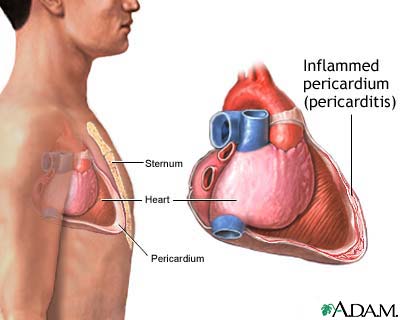Pericarditis - symptoms and treatment

What is Pericarditis and definition
Pericarditis is INFLAMMATION of the PERICARDIUM, the membranous sac that surrounds and protects the HEART. Pericarditis can be acute (comes on suddenly) or chronic (intermittent symptoms over a period of time), the result of an INFECTION or an autoimmune disorder such as RHEUMATOID ARTHRITIS. Infections are usually viral, with the coxsackie VIRUS and echovirus the most common culprits, though viral pericarditis may follow INFLUENZA or accompany AIDS. Bacterial pericarditis is less common and may occur after bacterial infection elsewhere in the body (such as STREP THROAT) or as a complication of an OPEN HEART SURGERY. Pericarditis may also develop after HEART ATTACK as an inflammatory response, typically with symptoms that begin within five days of the heart attack. Chronic pericarditis generally results from inflammatory processes not related to infection. Certain cancers, notably LEUKEMIA and KAPOSI’S SARCOMA, can involve the pericardium, causing ongoing or intermittent symptoms.
Any CHEST PAIN that persists longer than five minutes, especially pain that radiates into the arm and back, requires emergency medical evaluation to rule out HEART ATTACK.
Symptoms of Pericarditis
The primary symptoms of pericarditis are PAIN from the chest, usually that radiates to the back or into the upper arm and shoulder, COUGH, and shortness of breath. Pain is usually sharp, worse with BREATHING in or lying down and relieved when sitting or standing upright. These symptoms are initially difficult to distinguish from heart attack, and typically result in emergency medical evaluation to determine whether heart attack is taking place. Many people have FEVER with acute pericarditis, and upon AUSCULTATION (listening to the chest with a STETHOSCOPE) the doctor can hear a characteristic sound called a friction rub. The pain of pericarditis comes from the pericardium, not the heart, a result of the pericardium rubbing against the heart or the LUNGS and chest cavity.
A potentially life-threatening complication of pericarditis is the rapid accumulation of fluid in the pericardial space, a filmy envelope in the pericardium’s inner layer that normally contains a small amount of fluid to lubricate the beating heart. The fibrous outer pericardium does not have much ability to stretch to accommodate increased fluid, so the fluid instead pushes inward against the heart. The pressure restricts the heart’s ability to contract to fill with BLOOD, resulting in a dangerous condition called cardiac tamponade. BLOOD PRESSURE and HEART RATE drop perilously in cardiac tamponade, and the compression can cause the heart to stop beating entirely. Some increase in fluid usually occurs with pericarditis, as that is part of the body’s protective response to inflammation. When gradual and limited, such fluid increase does not usually affect the heart’s function as the pericardium can slowly expand in response.
Pericarditis Diagnosis and Treatment
The diagnostic path includes ELECTROCARDIOGRAM (ECG), which reveals any arrhythmias or strain on the heart, and ECHOCARDIOGRAM to visualize the heart and its related structures. Echocardiogram usually shows the inflammation and any fluid accumulation, and helps distinguish pericarditis from other conditions such as heart attack or restrictive HEART FAILURE. Additional imaging procedures may include COMPUTED TOMOGRAPHY (CT) SCAN or MAGNETIC RESONANCE IMAGING (MRI). Treatment may include NONSTEROIDAL ANTI-INFLAMMATORY DRUGS (NSAIDS) to relieve inflammation and pain, or CORTICOSTEROID MEDICATIONS if the inflammation is severe. Pericardiocentesis, in which the doctor uses a long needle and syringe to withdraw fluid from the pericardium, is necessary when fluid accumulation pressures the heart. Pericardiocentesis can determine whether the pericarditis is bacterial, in which case the doctor administers ANTIBIOTIC MEDICATIONS as well.
Most people who do not have underlying CARDIOVASCULAR DISEASE (CVD) or other significant systemic conditions make full and complete recovery within two or three weeks. Pericarditis can complicate cardiovascular disease. Systemic AUTOIMMUNE DISORDERS or inflammatory conditions may result in chronic pericarditis that may require ongoing anti-inflammatory therapy, usually with NSAIDs.
See also BACTERIA; CARDIOVASCULAR DISEASE PREVENTION; CORONARY ARTERY BYPASS GRAFT (CABG); ENDOCARDITIS; HIV/AIDS; MYOCARDITIS; TAMPONADE, CARDIAC.
Open discussion on the topic Pericarditis - symptoms and treatment
Similar interests
- Nuovi Casino
- Casinos Not On Gamstop
- UK Casinos Not On Gamstop
- Casinos Not On Gamstop
- UK Casinos Not On Gamstop
- Casino Non Aams Italia
- Slot Sites Not On Gamstop
- Meilleur Casino En Ligne
- Non Gamstop Casino Sites UK
- Meilleur Casino En Ligne
- Casino En Ligne France
- Best Non Gamstop Casinos
- Casinos Not On Gamstop
- UK Casino Not On Gamstop
- Casinos Not Signed Up To Gamstop
- Best Slot Sites UK
- Non Gamstop Casino Sites UK
- Online Casinos Nederland
- Online Casinos Nederland
- Casinos Not On Gamstop
- Best New Uk Casinos Not On Gamstop
- Casino Non Aams
- Non Gamstop Casinos UK